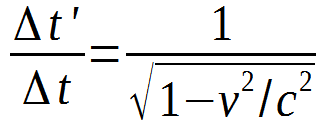Relative Velocity Time Dilation

"Passengers on an 8 hour long airline flight going 920 kmph land
having aged 10 nanoseconds less than people on the surface of
earth"(Davies). When something is moving faster than something else,
time dilation is experienced due to the discrepancy between
velocities. The equation used to quantify exactly how much time
changes at different speeds is as follows (To see how another
physics teacher derived this equation click here):

Where:
Δt' = The amount of time that passed in the
stationary object's reference frame
Δt = The amount of time that passed in the
moving object's reference frame
v = The velocity of the moving object
c = The speed of light
So, for example, if somebody travels on a spaceship going 50% the
speed of light for one hour, how much time elapsed for a stationary
observer on earth?
Given:
Δt = 1 hour
v = .5c
Find:
Δt'
The stationary observer would say that it took the spaceship 1 hour
and 9 minutes to cover the distance the spaceship actually traveled
in 1 hour.
The above equation can be graphed to show how much time is dilated
at various velocities expressed in fractions of the speed of light:

Taken from: http://commons.wikimedia.org/wiki/File:Time_dilation.svg
The graph makes it obvious that for a significant amount of time
dilation to be experienced, the velocity must be near the speed of
light. At around 86.6% of the speed of light, one hour on the moving
object would be equivalent to two hours on the stationary object. At
99.99% of the speed of light, one hour on the moving object would be
equivalent to about 71 hours on the stationary object. Time dilation
caused by relative velocities can be easily proven experimentally
with atomic clocks.
John Matson describes one of these experiments in his article "How
Time Flies". "In one landmark test, in 1971, Joseph C. Hafele of
Washington University in St. Louis and Richard E. Keating of the U.S
Naval Observatory flew cesium atomic clocks around the world on
commercial jet flights, then compared the clocks with reference
clocks on the ground to find that they had diverged, as predicted by
relativity. Yet even at the speed and altitude of jet aircraft, the
effects of relativistic time dilation are tiny - in the
Hafele-Keating experiment, the atomic clocks differed after their
journeys by just tens to hundreds of nanoseconds" (Matson).
With one atomic clock remaining stationary and another moving at any
velocity, the one remaining stationary will always tick faster than
the one moving, given that they are at the same distance from the
center of a gravitational field to ensure that gravitational time
dilation is not the culprit.

Next: Gravitational Time Dilation
Previous: What is Time Dilation?
Title Page

